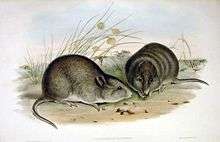Potoroo
| Potoroos[1] | |
|---|---|
 | |
| Potorous platyops | |
| Scientific classification | |
| Kingdom: | Animalia |
| Phylum: | Chordata |
| Class: | Mammalia |
| Infraclass: | Marsupialia |
| Order: | Diprotodontia |
| Family: | Potoroidae |
| Subfamily: | Potoroinae |
| Genus: | Potorous Desmarest, 1804 |
| Type species | |
| Didelphis murina Cuvier, 1798 (=Didelphis tridactlya Kerr, 1792) | |
| Species | |
A potoroo is a kangaroo-like marsupial about the size of a rabbit. It is a macropod. All three extant species are threatened, especially the long-footed potoroo (Endangered) and Gilbert's potoroo (Critically Endangered). The main threats are predation by introduced species (especially foxes) and habitat loss. Potoroos were formerly very common in Australia, and early settlers reported them as being significant pests to their crops.
Gilbert's potoroo is Australia's most endangered animal. The species was discovered in 1840 by a naturalist called John Gilbert. It was then thought to have become extinct until being rediscovered in 1994 at the Two Peoples Bay Nature Reserve (near Albany) in Western Australia. Conservation efforts have grown an initial wild population of 30-40 to over 100.[2]
Classification
A potoroo is any member of the genus Potorous.
- Suborder Macropodiformes
- Family Potoroidae
- Subfamily Potoroinae
- Genus Potorous
- Gilbert's potoroo, P. gilbertii
- Long-footed potoroo, P. longipes
- †Broad-faced potoroo, P. platyops
- Long-nosed potoroo, P. tridactylus
- Genus Potorous
- Subfamily Potoroinae
- Family Potoroidae
References
- ↑ Groves, C.P. (2005). Wilson, D.E.; Reeder, D.M., eds. Mammal Species of the World: A Taxonomic and Geographic Reference (3rd ed.). Baltimore: Johns Hopkins University Press. p. 58. OCLC 62265494. ISBN 0-801-88221-4.
- ↑ "World's rarest marsupial fighting back". SBS News. December 2014.
External links
| Look up potoroo in Wiktionary, the free dictionary. |
- http://www.deh.gov.au/cgi-bin/sprat/public/publicspecies.pl?taxon_id=66645
- http://animaldiversity.ummz.umich.edu/site/accounts/classification/Potorous.html
- http://www.museum.vic.gov.au/bioinformatics/mammals/images/longlive.htm